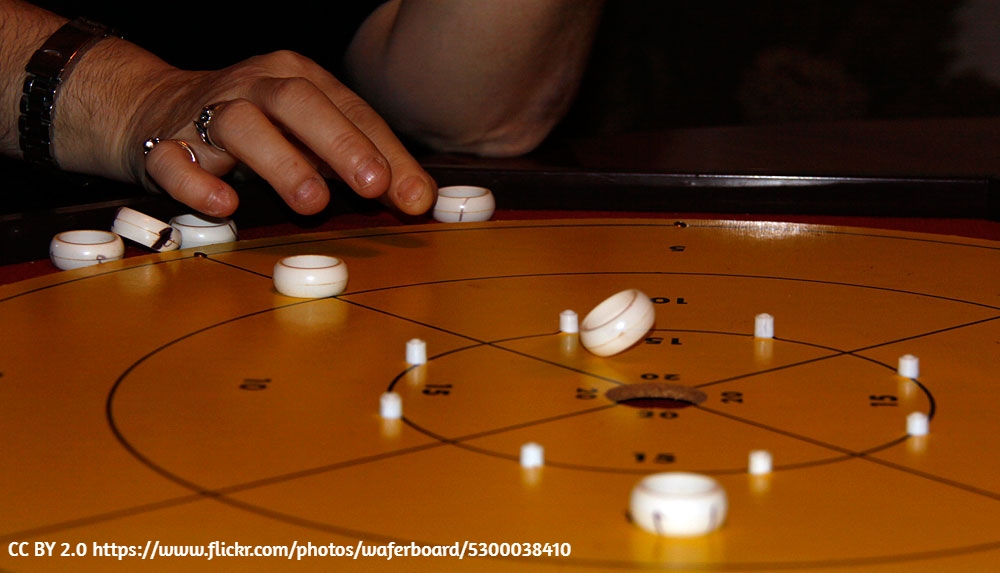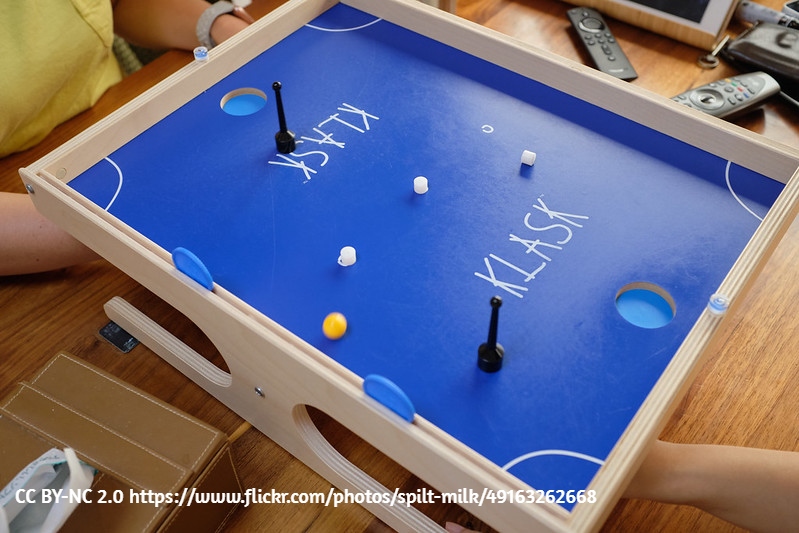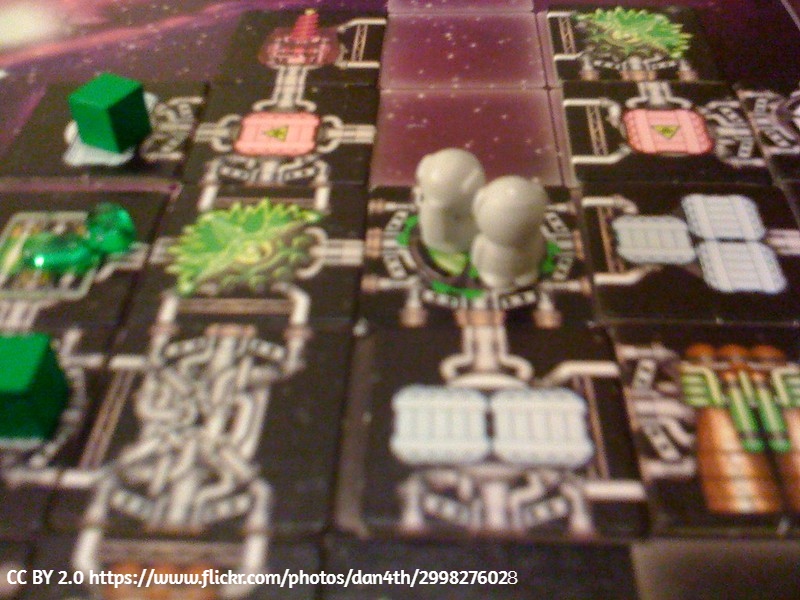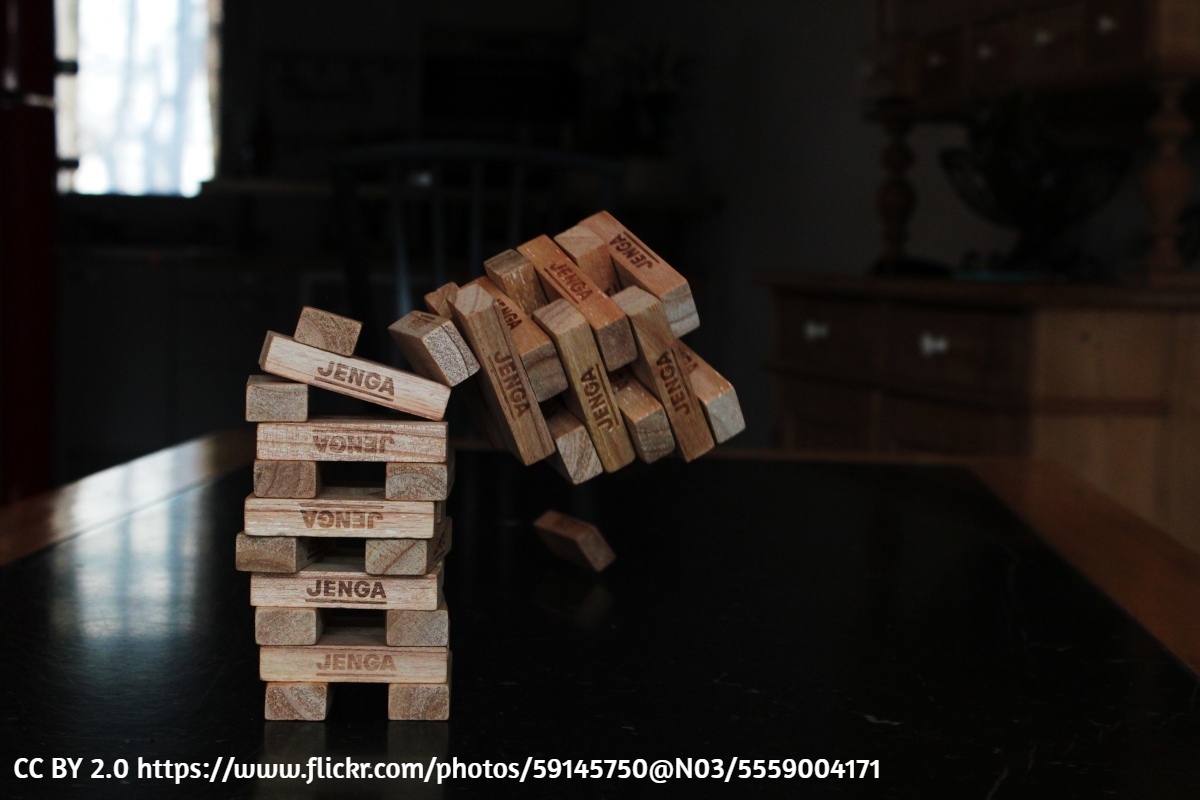BoardGameGeek has little love for Jenga. And yet the game has sold over 50 million copies. And Amazon currently offers 7 pages of Jenga versions, expansion, variants and spinoffs. Jenga classic, selling for $12 (probably earning Hasbro a very fat profit), is currently #59 in all Toys & Games at Amazon.
Word-of-mouth has been, and may forever be, the most persuasive form of marketing. People can see each other playing Jenga. They are aware of the game’s existence. And building awareness is the first and often the hardest stage for indie game publishers.
Jenga achieves this awareness through its huge, toppling, loud towers of blocks — and through the rush of raucous excitement and dismay that players experience and express. Getting players up out of their seats is a powerful way to attract attention to a table.
So aside from building towers, what are other ways that games get players moving? Well, getting people moving challenges them to move well. We’re squarely in the world of dexterity games — some of which score much higher than Jenga on BGG. So there’s apparently a way to design a dexterity game that even hardened BGG users can appreciate. 😉 Let’s learn.
Flicking
The highest-ranked dexterity game on BGG is Crokinole, with an overall game rank of 56 and a rating of 8.0. Invented in 1876, the game involves flicking disks at a hole. That seems to be it, with some additional pegs and scoring regions thrown in for additional challenge.

Some quotes from BGG reviews of this game about why it’s so great:
- “The strategy of trying to hit other disks while also trying to position yours is fantastic.”
- “There are scoring areas you are aiming but you first have to touch an opponent’s disc with yours. You can help/hinder your opponent by hitting his discs and moving them to a different area or out of the board altogether.” (This is from a rating of 4.0.)
- “The satisfaction of the flick, glide and clack of disks has to be experienced.”
- “I like PitchCar more but this is better for a quick team game.”
My takeaway is that the game succeeds because it combines a satisfying tactile challenge with a satisfying tactical challenge, especially in the context of team play. It’s more than just flicking stuff at a target. It’s also about the juiciness of deciding which targets to go after, and how.
Other flicking games include:
- PitchCar (which also has players assemble a customizable racetrack)
- Catacombs
- Coconuts (which appears to have a device for flicking coconuts)
- Flick of Faith
Manipulating
The second-highest-ranked dexterity game on BGG is KLASK, with an overall rating of 7.6. Again, we’re aiming to get a ball into a hole. This time, though, the players manipulate the ball using a magnet under the board, and they actively try to prevent one another’s progress.

Rummaging
BGG categorizes Galaxy Trucker (rating 7.6) as dexterity, perhaps because it involves creating a huge pile of cards and then furiously rummaging through the top-most cards in real time for what players need. They assemble these cards and other components into a spaceship (below), which provides more of a Eurostyle crunchiness and accounts for this game’s weight of 2.36. Most dexterity games have a weight under 2.0.

Stacking
And, of course, we have Jenga-like games that simply involve stacking. An example is the highly-ranked Junk Art (BGG rating 7.4), in which players stack plastic or wooden pieces. As with Jenga, they try not to let the stack fall down, but each player in this case has their own stack of junk art that they need to grow (vs Jenga, which has a shared stack).
Other stacking games include:
Notes to self
- The list above is a nearly-complete set of all high-ranked dexterity games that achieved a rating of 7.0 or higher on BGG.
- There are a few others that I couldn’t figure out why they are dexterity games. (Example: Pictomania, ie drawing pictures).
- Dexterity games can have some complexity (Example: Galaxy Trucker).
- Other mechanics mentioned in 10 best dexterity games that are better than Jenga | Dicebreaker
- Dr. Eureka manipulates balls using flasks
- Cube Quest has players flick to destroy one another’s castles
- Fungeon Party appears to have bowling and some furious dice rolling
- Most games above use a limited set of physical principles:
- Positive impulse (delta momentum)
- Gravity
- Positive support (stackable pieces, supporting table)
- Negated support (gaps, holes)
- Positive constraints (piling of cards in Galaxy Trucker)
- Other potential physical principles:
- Negative impulse (e.g., catching)
- Electromagnet force (e.g., magnetic as in Klask, or picking up flakes using static electricity)
- Other positive constraints (e.g., serial containment)
- Combinations of principles (e.g., impulse at a structure exhibiting positive support, as in Cube Quest)
